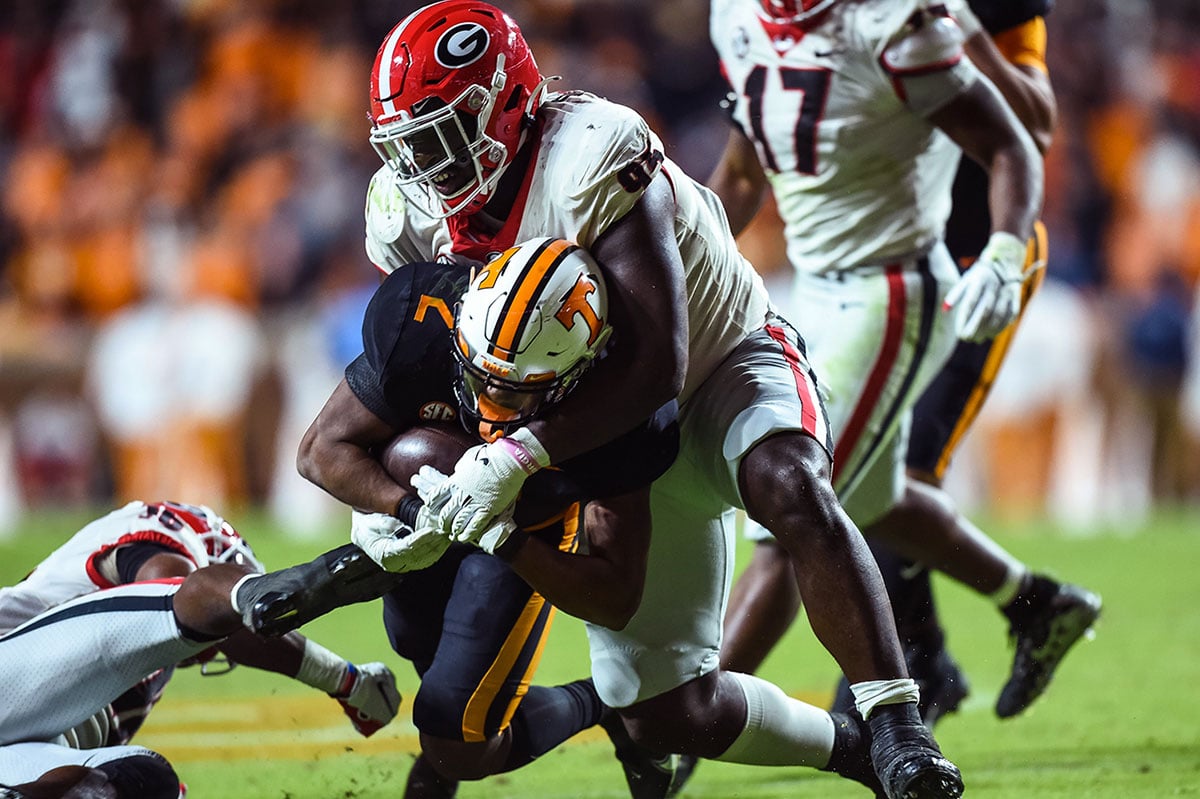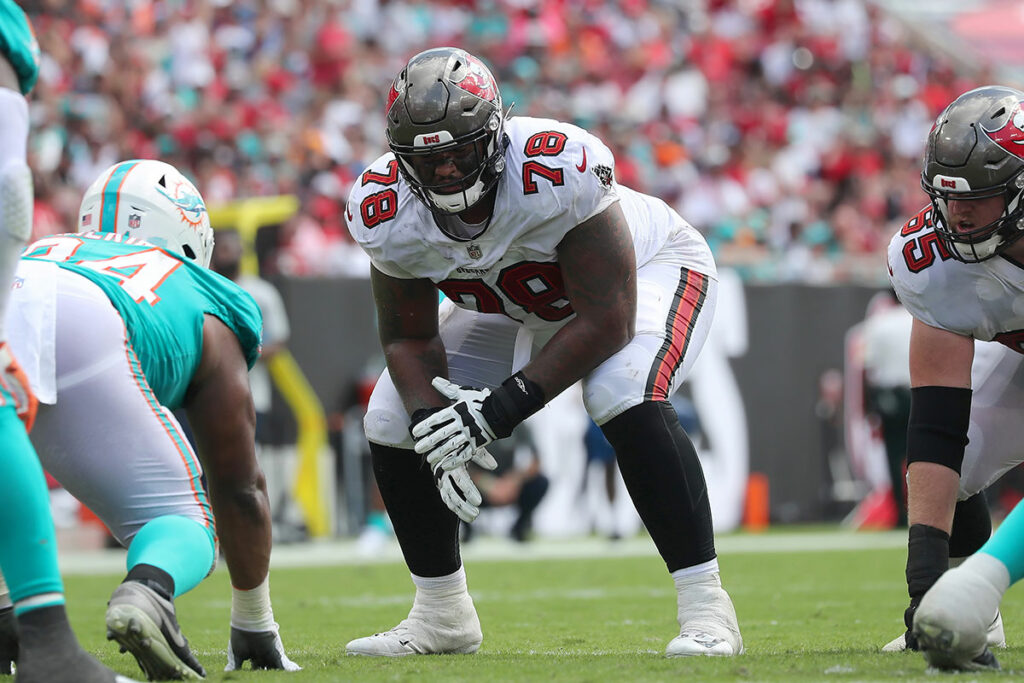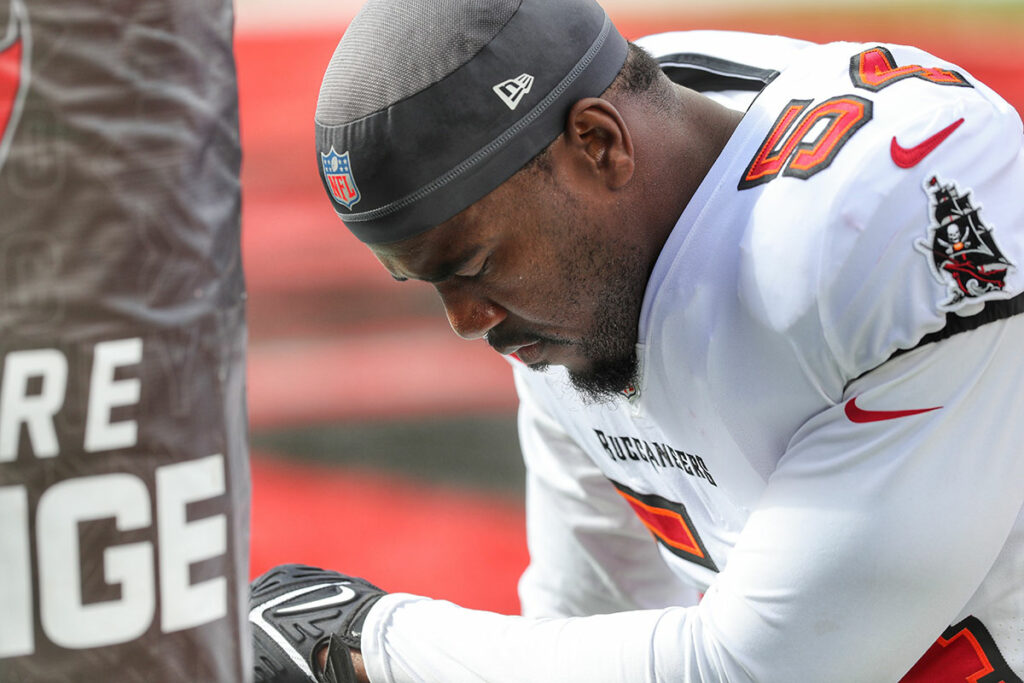In this week’s Bucs Briefing, I release my 2022 NFL Draft defensive tackle rankings and round grades. There are a few pro days left, so a couple things may still shift before the draft. But this is likely to be my final ranking of the class.
Keep in mind, my round grades are handed out in a vacuum. Each round grade is tied to the caliber of player I believe each prospect will be in the NFL. It is NOT a projection of where I believe they will or even should be drafted in the actual draft. Instead it is a level of valuation I have tied to each player’s outlook for the NFL.
If you want to see my past NFL Draft defensive tackle rankings, here they are:
2020 NFL Draft DT Rankings
2021 NFL Draft DT Rankings
Here are the 2022 NFL Draft defensive tackles I still need to complete evaluations for.
Neil Farrell, LSU
Zach Carter, Florida
Kalia Davis, UCF
Otito Ogbonnia, UCLA
Eric Johnson, Mississippi State
10. John Ridgeway, Arkansas (6-5, 321, 5.30)
Ridgeway has some head-snapping power that could translate to being a rotational nose tackle in the NFL. Some of his reps are comical, the way he locked with heavy hands to control opposing centers. But there’s no upside and no pass rush impact here. If Ridgeway makes it in the NFL, it’ll be as a pure early-downs nose tackle. And even as a run-stuffer, his area of impact is limited. Ridgeway just isn’t a good enough athlete to play a major role in the NFL, despite how powerful he is. Honestly, with his size, length, grip strength and violent hands, I would try to move him to guard.
Grade: 5th Round (Backup)
9. Eyioma Uwazurike, Iowa State (6-6, 316, 5.32)
Uwazurike had nine sacks last season for Iowa State! Nine sacks? For a college defensive tackle? Why isn’t he getting more hype?
Well, I watched all nine sacks. Uwazurike either wasn’t blocked or had the quarterback run right to him on at least eight of the sacks. So yes, that box score production is extremely deceiving. But Uwazurike does have good quickness and agility for a massive defensive tackle. If he can learn some pass rush moves, I could see him being a contributor down the road. Right now, Uwazurike needs to develop his technique and get stronger. If he lands in the right system, I think Uwazurike has a shot to be a contributor down the road.
Grade: 5th Round (Backup)
8. Phidarian Mathis, Alabama (6-4, 310, DNP)
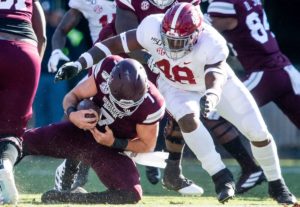
Alabama DT Phidarian Mathis – Photo by USA Today
Mathis feels like one of the easier evaluations in this defensive tackle draft. He’s physically maxed out, but has a pro-ready build. Athletically, there’s not much of a ceiling for Mathis to work with. It’ll be a massive upset if he ever makes more than a few dents as a pass rusher. He’s a bull rush-only defensive tackle, without the explosiveness or agility to be much more. That was also evident at the Senior Bowl, where Mathis had a quiet week.
But in the locker room and on the sideline, Mathis’ leadership can help. He’s not a perfect run defender, but he plays with generally good technique and an outstanding motor. He’ll lead vocally and by example in the trenches. Mathis’ power and length will help him make a quick transition to the field at the next level. I’ll be surprised if Mathis is ever a great, every-down player in the NFL. But I’ll also be stunned if he isn’t a competent contributor up front during his career.
Year 1 Outlook: Rotational Defensive Lineman
Year 3 Outlook: Rotational Defensive Lineman
Grade: 4th Round (Good Backup)
7. Matthew Butler, Tennessee (6-4, 297, 4.98)
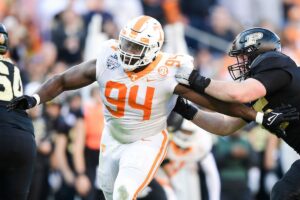
Tennessee DT Matthew Butler – Photo Credit Syndication: Knoxville News-Sentinel
Butler isn’t quite as pro-ready as Mathis, but his upside is more significant. I doubt there is a hidden gem in this interior defensive line draft, but if there is, it’ll be Butler (of the players I’ve seen). The Vols defensive captain has two key things working in his favor: an explosive first step and a violent style of play. Butler hurls himself into blockers, but has the athleticism to work around them, too. There are real traits worth working with in the run and pass game.
Unfortunately, his processing isn’t always where it needs to be. Butler’s play style is not very instinctive, which can lead to minimal plays around the ball. His technique and gap control are inconsistent, as more savvy offensive linemen used his aggressiveness against him. Over time, I could see Butler as a desirable third or fourth defensive tackle who is able to spell starters in the run and pass game without a major drop-off. He needs to clean up his pad level and refined his pass rush approach considerably. But, in this draft, Butler is worth taking a chance on, especially given the positive reports on his intangibles.
Year 1 Outlook: Backup
Year 3 Outlook: Good Backup/Rotational DL
Grade: 4th Round (Good Backup)
6. Perrion Winfrey, Oklahoma (6-4, 290, 4.89)
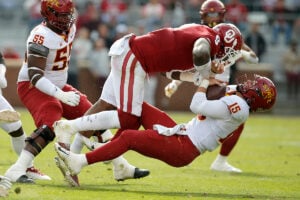
Oklahoma DT Perrion Winfrey – Photo by: USA Today
The only reason for hesitation on Winfrey’s evaluation is how well he played in Mobile. I found Winfrey’s tape to be decidedly below average. While explosive, he plays with very poor pad level and situational awareness. Winfrey was often running by plays, bulling into blockers with reckless abandon for gap assignments. In pretty much every way, Winfrey will be a significant run game liability to begin his career. That’s hard to overlook unless he offers difference-making impact as a pass rusher.
To be honest, there are flashes for Winfrey. A good first step off the ball is a great building block for a defensive lineman. And Winfrey has that explosiveness. He also has violent, powerful hands. If you just peek at his highlight reel from last season, you’ll see a couple reps where he blows up a smaller blocker. But if you watch his tape, you’ll see many more examples of him trying to bull rush on almost every rep. On several of those plays, Winfrey ended up on the ground.
Essentially Winfrey’s frenetic style of play is simply too chaotic to thrive in the NFL without more refinement. In the NFL, it will be much harder for an undersized defensive tackle to bully his way to pressures against stronger, more technical offensive linemen. Winfrey plays with an awesome motor and physical traits that are worth developing. His arm length and burst are major tools to work with. But it’s hard to buy into him as an early career difference-maker.
Year 1 Outlook: Backup
Year 3 Outlook: Good Backup/Rotational DL
Grade: 4th Round (Good Backup)
5. Logan Hall, Houston (6-6, 283, 4.88)
It was important for Hall to weigh-in heavy at the Combine, and he did. After being listed in the 260s, Hall checked a box by getting to 283 pounds. Then he blew up the testing, showing elite explosiveness and agility for a defensive tackle. Hall tested well enough to get occasional reps outside the tackle as a pro. But he didn’t play edge defender in college. That’s pretty important to consider. Hall is going to be a defensive tackle in the NFL. So grading him there made the most sense.
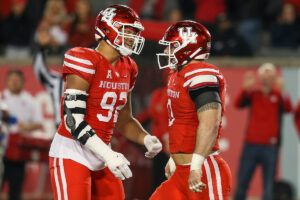
Houston DT Logan Hall – Photo by: USA Today
It is remarkable how low Hall is able to keep his pads in the run game despite being over 6-6. His flexibility is consistently obvious on tape, as he fires into blockers with every ounce of ferocity in his lighter-than-normal frame. Hall is ultra physical and aggressive, which mostly made up for his lack of mass and length in college.
But being 283 pounds in the NFL with sub-33 inch arms might matter in the NFL. Hall has to protect a lot more vertical surface area than most defensive tackles. Being able to lock out and keep blockers off his frame is important. But on tape, Hall is wrestling body-to-body with linemen a little too often. He has to clean up things like hand placement, arm extension and reading out blocks to become more consistent. Eventually, Hall needs to be able to control blockers more often. Right now, there are a lot of stalemates that will become losses outside of the AAC.
It’s not too different for Hall as a pass rusher. There are flashes of brilliance – a chop to get in clean, a swim to clear a flailing punch with ease. But then there are also clumsy reps where Hall ends up totally locked up. His lack of counter moves is something to work on too. When Hall gets caught on his initial move, the fight is usually over.
But he plays with an awesome motor and has terrific tools to work with. If Hall can ever normalize his best plays, he’ll be an impact player in the NFL. Like DeMarvin Leal, consistency and development will be key. Hall has the frame to keep bulking up too. His career may start slow, but by year three he should be a starter. In this draft, I’d want to invest in him on day two.
Year 1 Outlook: Rotational Defender
Year 3 Outlook: Solid-Good Starter
Grade: Early 3rd Round (Solid-Good Starter)
4. DeMarvin Leal, Texas A&M (6-4, 283, 5.0)
Leal is probably the hardest player on this list to rank. He has a couple plays in basically every game where he looks like a first-round prospect. Then there are a handful of plays where you wonder how he’ll survive in the NFL. Part of the struggle is how often he moves positions at Texas A&M. Per PFF, Leal played 57 A-gap snaps, 174 B-gap snaps, 50 snaps over the tackle and 414 outside the tackle last season.
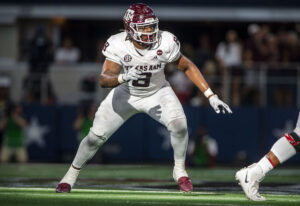
Texas A&M DT DeMarvin Leal – Photo Credit: Jerome Miron-USA TODAY Sports
That’s an absurd amount of outside snaps for a 283-pounder who is unlikely to align there in the NFL. But Leal has enough explosiveness to actually test tackles even on the edge. Not many players Leal’s size can burst and bend like he can. If you’re drafting Leal, it’s because you’re going all in on pass rushers up front. He’s at his best in an attacking, penetrating group where he can stay fresh in a rotation. Very few defensive tackles understand how to throttle down and cross the face of a blocker in space.
If Leal had more reps as an interior rusher, perhaps he’d be even higher on this list. But I struggle to see him as a full-time player right now. He doesn’t have the lateral agility and speed to play on the edge in the NFL, outside of pass-obvious situations. And at 283 pounds with inconsistent technique, Leal will get punished inside too often in the run game. He’s not hopeless in there, but there are enough low-end reps to have doubts.
Are there certain schemes that could play heavily to Leal’s strengths, minimizing his flaws? In some ways, Leal reminds me of Dre’Mont Jones in Denver. Jones was a liability in the run game in college, but flashed pass rush potential. That potential has manifested itself with 93 pressures and 16 sacks in three seasons. Now, Jones is a part-time player due to his limitations. But he’s arguably the most valuable type of part-time player in the NFL. If Leal can become that, he’ll be worth an early Round 3 pick at least.
Year 1 Outlook: Pass Rush Specialist
Year 3 Outlook: Solid-Good Starter
Grade: Early 3rd Round (Solid-Good Starter)
3. Travis Jones, UCONN (6-4, 325, 4.92)
Like Jordan Davis and Devonte Wyatt, Jones feels like a pretty safe pick. Yes, he played against worse competition than those two in the AAC. But he was also on one of the worst teams in college football. Clemson’s offensive line was terrible last year, but Jones tossed them around all game. What’s perhaps most impressive is the frequency with which Jones dominates in the run game despite average pad level. His strength is the real deal, even by NFL standards.
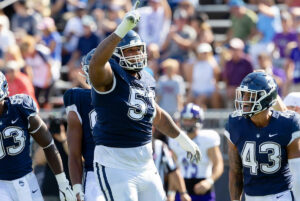
UConn DT Travis Jones – Photo by: UConn
The downside with Jones is he just doesn’t offer much explosiveness off the ball. He’s laterally stiffer than Davis, unable to slip through gaps or play in space to the same degree. But Jones flashed a lot more than Davis as a pass rusher, understanding that the offensive lines on his schedule were brutally bad. I think Jones can be a capable rusher in the NFL. He uses actual moves to attack the edge of his opponent. That’s typically a good sign, when college defensive tackles don’t just try to bull rush all game.
I ultimately moved Davis ahead of Jones because of a few factors. First, Davis dominated better competition. That doesn’t mean Jones wouldn’t have, I just haven’t seen it. Although Jones was very good at the Senior Bowl in Mobile. I also think Davis is the more dominant run defender. He can impact opposing run games more than Jones, and in a greater variety of ways. While Jones played the B-gap a lot in college, he will be a nose tackle for most teams in the NFL. I could see Davis being asked to do more because of his quickness.
So it’s close. And Jones might be the better pass rusher right away. But will he be good enough as a rusher to negate Davis’ run game dominance? And how he frees up the rest of the front seven to be better? I’m betting on the Georgia star, by a hair.
Year 1 Outlook: Rotational Defender/Solid Starter
Year 3 Outlook: Good-Very Good Starter
Grade: Second Round (Good-Very Good Starter)
2. Jordan Davis, Georgia (6-6, 341, 4.78)
The best part about drafting Davis is that you know you are getting at least a good player in the NFL. Few run-stuffers have ever been as unblockable as Davis. He’s essentially never moved against SEC competition, anchoring his gap and playing through blocks to bring down ball carriers. Davis’ physicality and massive frame will undoubtedly provide a similar challenge for NFL offensive linemen. I think his traits are elite enough in this area to make a quick transition to the pro level.
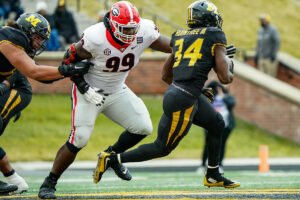
Georgia NT Jordan Davis – Photo by: USA Today
The quandary with Davis is in determining how valuable his skill set is. Last season, Davis played a career-high 378 defensive snaps. That’s around 27 snaps per game, with almost no impact on passing downs. I mean, over the course of a season Davis would beat a pass protector one-on-one maybe five times. Pressures and sacks were hard to come by, and even harder to earn without the aid of blitzes and twists up front. Or coverage sacks thanks to an elite secondary. The fact that we are even talking about a zero pass rusher being selected this high in the draft is a testament to how dominant Davis is against the run.
The greatest value a defensive tackle can have is their ability to play behind the line of scrimmage. If they aren’t impactful in that area of the field, I can’t ascribe a first-round value to them. I don’t think Davis is impactful enough there to carry a first-round value. But, he’s quicker through gaps as a run defender than you’d think, and his range of impact is significant up front. Davis is so dominant as a run defender that he will make life easier on the rest of a team’s front seven, too. He may even allow a team to lighten the box and commit more early down defenders to coverage.
Davis makes an impact in enough ways to be happy about drafting him even though he will probably never be a dominant pass rusher.
Year 1 Outlook: Rotational Defender/Solid Starter
Year 3 Outlook: Good-Very Good Starter
Grade: Second Round (Good-Very Good Starter)
1. Devonte Wyatt, Georgia (6-3, 304, 4.77)
People at Georgia point to 2021 as the year things finally clicked for Wyatt. But the ability was always there. Yes, he’s already 24 years old. But he’s an outstanding athlete with a pro-ready body coming from SEC competition. And the whole draft class is older than most. Wyatt’s tape is impressive enough to feel confident in what you’re getting, even if he beat up on younger players last year.
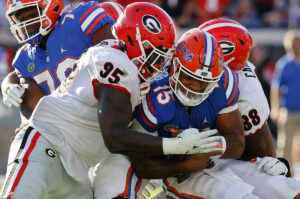
Georgia DT Devonte Wyatt – Photo by: USA Today
As a run defender, it’s hard to have a ton of complaints about Wyatt. He can hold the point of attack, slip through creases up front or make plays away from his gap. Wyatt’s motor runs hot, allowing him to act as a defense’s energizer bunny on the field. I would expect a quick and versatile transition to the NFL for Wyatt on run downs.
Can all of that translate to passing downs? Wyatt has flashed as a pass rusher, and showed excellent growth this season. But he still lacks a go-to pass rush moves and counters when his plan is stymied. He needs to fire off the ball with a more refined plan of attack.
However, I think an NFL system could help Wyatt in that regard. Georgia was a very scheme-heavy defensive team on passing downs. Wyatt, like all Georgia defensive linemen, operated primarily in a series of twists and stunts up front. In the NFL, he’ll get more opportunities to compete one-on-one. Amidst this draft class, it’s hard to see any defensive tackle that has the ceiling of Wyatt. And his floor is still quite high. As long as he’s focused on football, there’s not much downside to selecting Wyatt in the draft.
Year 1 Outlook: Solid Starter
Year 3 Outlook: Good-Very Good Starter
Grade: Second Round (Good-Very Good Starter)
Jon Ledyard is PewterReport.com's newest Bucs beat writer and has experience covering the Pittsburgh Steelers as a beat writer and analyzing the NFL Draft for several draft websites, including The Draft Network. Follow Ledyard on Twitter at @LedyardNFLDraft

